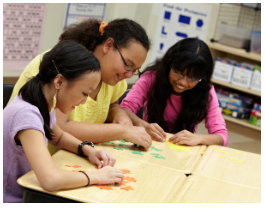By: Margo Ensz on May 15th, 2014
Digging Deeper into Student Engagement
 The phrase “student engagement” is used frequently in the realm of the education, but has this frequency led to the dilution of its meaning? ASCD’s Inservice hosted a number of guest bloggers during their Student Engagement Week in April, and we were thrilled and inspired by the depth of research and the breadth of suggestions.
The phrase “student engagement” is used frequently in the realm of the education, but has this frequency led to the dilution of its meaning? ASCD’s Inservice hosted a number of guest bloggers during their Student Engagement Week in April, and we were thrilled and inspired by the depth of research and the breadth of suggestions.
Michael F. Opitz and Michael P. Ford, authors of Engaging Minds in the Classroom: The Surprising Power of Joy contributed a post titled, “Engage Students (and Entertain Them a Little, too!)” which dissected the difference between entertainment and engagement, and how they work together. Too often, the authors argue, educators misunderstand a student’ entertainment as synonymous with engagement. “Engagement draws us into our daily lives, whereas entertainment does the opposite; we seek it out to distract us from our daily lives. It diverts us from attending to important matters.” However, teachers should not discount the effectiveness of entertainment, as it can be a powerful tool to spark a student’s interest. “In essence, joy leads students to learning rather than away from it.”
“Caring about students beyond the boundaries of the classroom is the first step of sparking engagement.” Beth Morrow, a middle school ESL teacher in Columbus, offered her own insight on the meaning of and path to student engagement in her contribution, “The Myth of Student Engagement.” Morrow believes that student engagement begins with teacher engagement, and warns that “when teachers forget that a large part of being a successful educator relies on being a learner yourself, student perception begins to shift.” She suggests educators ask themselves if they are truly attempting to engage students or simply teaching at them: “True engagement comes when a teacher knows a student’s strengths and interests beyond the classroom and uses that knowledge to deepen relationships. If we go into our rooms each day to teach but not connect, we can’t expect students to care beyond a test score, if that.”
This same week, the April 2014 issue of Educational Leadership published a collection of writing assigments submitted by teachers nationwide for the topic, “Tell Me About…A Writing Assignment That Engaged Your Students.” Here are a few examples, but you can view the full list here!
A Note from the Person Who Knows Me Best
I assigned students in my 8th grade AVID class to write letters to themselves that they would read on their first day of high school. It was an opportunity to give their future selves encouragement, advice, and inspiration. By the time they received the letters in their 9th grade homeroom classrooms the following year, many had forgotten about the assignment. Some students wrote to me later that the letters had bolstered their confidence and that they were pleased to see how much their writing had improved over the school year.
—Ashanti Foster, academic dean, Oxon Hill Middle School, Ft. Washington, Maryland
Let the Object Speak to You
I keep a collection of "found objects" that I have picked up on the ground. I tell students to reach into my collection and "let the artifact choose you." They must hold onto the object and allow it to speak to them. They can begin by writing a physical description, letting the object jog a memory as they capture its essence. Then the real writing begins; usually, memories pour out of the students faster than they can write them down. I have done this lesson with 3rd graders, high school students, and adult learners. It has never failed to turn even my most reluctant writers into more confident ones, believing that they have important stories to tell.
—Kathy Moore, curriculum coordinator, San Ramon Valley Unified School District, Danville, California
Reflections on a Science Topic
One of our high school's goals was to increase students' reading of informational text in their academic and elective classes. So to start off the year, I gave students in my chemistry class the article "It's Time to E-volve: Taking Responsibility for Science Communication in a Digital Age" by Christie Wilcox (Scientific American, August 2012) as a writing prompt. The author writes that all scientists should blog, tweet, and throw themselves into the social media revolution. Students read the article and wrote papers agreeing or disagreeing with the author's argument and citing evidence from the article to support their position. Students reflected on their own use of social media and how it could affect their future careers.
—Stacie Ferrara, vice principal, Manchester Township High School, Manchester, New Jersey
